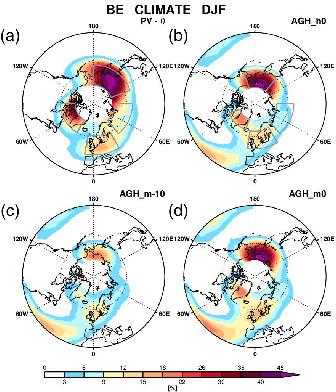当前位置:
X-MOL 学术
›
Q. J. R. Meteorol. Soc.
›
论文详情
Our official English website, www.x-mol.net, welcomes your feedback! (Note: you will need to create a separate account there.)
Reconciling different methods of high‐latitude blocking detection
Quarterly Journal of the Royal Meteorological Society ( IF 8.9 ) Pub Date : 2020-12-19 , DOI: 10.1002/qj.3960 Evangelos Tyrlis 1 , Jürgen Bader 1, 2 , Elisa Manzini 1 , Daniela Matei 1
Quarterly Journal of the Royal Meteorological Society ( IF 8.9 ) Pub Date : 2020-12-19 , DOI: 10.1002/qj.3960 Evangelos Tyrlis 1 , Jürgen Bader 1, 2 , Elisa Manzini 1 , Daniela Matei 1
Affiliation

|
Blocking is associated with outbreaks of easterlies induced by a continuum of features including anticyclones, cyclones or both. Blocking identification methods disagree on the levels of high‐latitude blocking (HLB) activity. We investigate the cause of the disagreement in HLB activity over the Northern Hemisphere obtained by two 2D methods: the PV– index and the Absolute Geopotential Height (AGH) reversal method. Although both classify as absolute field methods, the former yields nearly twice the winter HLB activity of the latter method. We show that this discrepancy is caused by the addition of a poleward criterion in the AGH method that requires strong poleward westerlies. The additional criterion in the AGH method shifts the focus on the detection of blocking ridges and thus other blocking circulation patterns are under‐represented. Both methods agree on the climatology of midlatitude blocking because the poleward criterion has been tuned to capture the strong midlatitude blocking, but the discrepancy grows in high latitudes. HLBs are different because they occur on the northern flank of the westerlies and are associated with the equatorward displacement of the midlatitude jet. HLB anticyclones are weaker and do not induce strong poleward westerlies compared to their midlatitude counterparts. The implementation of a strict poleward criterion designed to identify midlatitude blocks rejects many HLBs. The use of the less strict cut‐off threshold (CT) of 0 m (°lat)−1 in the poleward criterion for latitudes higher than 60°N results in the convergence of climatology, interannual variability and trends of HLB between the two methods, especially during winter. The additional HLBs identified by the modified AGH algorithm develop from cyclonic wave breaking that is typical for oceanic blocking. The modified AGH method can be useful in detecting more robust HLB trends in climate model projections.
中文翻译:

调和不同的高纬度阻塞检测方法
阻塞与由连续特征(包括反气旋和/或旋风)引起的东风爆发有关。阻止识别方法在高纬度阻止(HLB)活动级别上存在分歧。我们调查了通过两种2D方法获得的北半球HLB活性不一致的原因:PV–指数和绝对地势高度(AGH)逆转方法。尽管两种方法都归类为绝对野外方法,但前者的冬季HLB活性几乎是后者的两倍。我们表明,这种差异是由于在AGH方法中增加了极向性准则而引起的,该准则要求强极向性西风。AGH方法中的附加标准将重点转移到了阻塞脊的检测上,因此其他阻塞循环模式的代表性不足。两种方法在中纬度阻塞的气候学上都一致,因为已经调整了极向判据来捕获强中纬度阻塞,但是在高纬度地区差异越来越大。HLB之所以不同,是因为它们出现在西风的北翼,并且与中纬度急流的赤道位移有关。与中纬度对应物相比,HLB反气旋较弱并且不会引起强烈的极向西风。旨在识别中纬度区块的严格极地准则的实现拒绝了许多HLB。使用不太严格的阈值(CT)0 m(°lat)对于高于60°N的纬度,极向判据中的-1导致两种方法之间的气候学,年际变化和HLB趋势的趋同,尤其是在冬季。通过改进的AGH算法识别出的其他HLB是从气旋波折断发展而来的,这是典型的海洋阻塞。改进的AGH方法可用于检测气候模型预测中更健壮的HLB趋势。
更新日期:2020-12-19
中文翻译:

调和不同的高纬度阻塞检测方法
阻塞与由连续特征(包括反气旋和/或旋风)引起的东风爆发有关。阻止识别方法在高纬度阻止(HLB)活动级别上存在分歧。我们调查了通过两种2D方法获得的北半球HLB活性不一致的原因:PV–指数和绝对地势高度(AGH)逆转方法。尽管两种方法都归类为绝对野外方法,但前者的冬季HLB活性几乎是后者的两倍。我们表明,这种差异是由于在AGH方法中增加了极向性准则而引起的,该准则要求强极向性西风。AGH方法中的附加标准将重点转移到了阻塞脊的检测上,因此其他阻塞循环模式的代表性不足。两种方法在中纬度阻塞的气候学上都一致,因为已经调整了极向判据来捕获强中纬度阻塞,但是在高纬度地区差异越来越大。HLB之所以不同,是因为它们出现在西风的北翼,并且与中纬度急流的赤道位移有关。与中纬度对应物相比,HLB反气旋较弱并且不会引起强烈的极向西风。旨在识别中纬度区块的严格极地准则的实现拒绝了许多HLB。使用不太严格的阈值(CT)0 m(°lat)对于高于60°N的纬度,极向判据中的-1导致两种方法之间的气候学,年际变化和HLB趋势的趋同,尤其是在冬季。通过改进的AGH算法识别出的其他HLB是从气旋波折断发展而来的,这是典型的海洋阻塞。改进的AGH方法可用于检测气候模型预测中更健壮的HLB趋势。


























 京公网安备 11010802027423号
京公网安备 11010802027423号